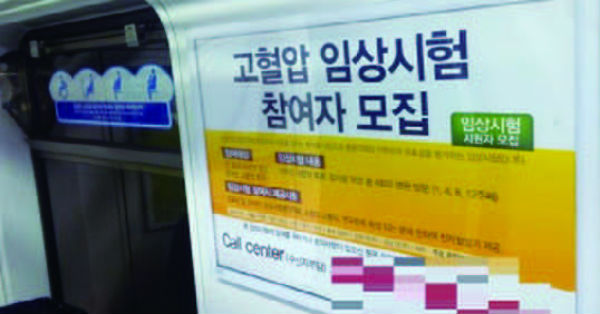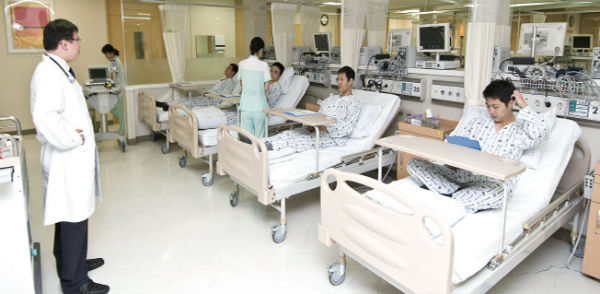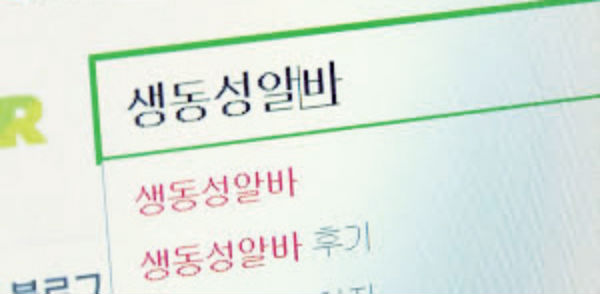Clinical research subjects are recruited. Participants should be 25 to 60 years old and benefits for the participants include medical and transportation expenses. Anyone who has ever been on a subway has probably seen this kind of advertisement. These are advertisements that recruit participants for clinical trials. These advertisements can trigger the temptations of people to apply for them, as the advertisements say that subjects can earn money by simply lying down and taking drugs. Clinical trial systems, however, have many loopholes. The Sungkyun Times (SKT) now introduces to Kingos what clinical trials are, the problems of Korean clinical trial systems, and possible solutions.
What Are Clinical Trials?
About Clinical Trials

Clinical trials are tests to demonstrate the stability and efficacy of new drugs and to investigate their adverse reactions on people. It is a process that confirms the safety and effects of new drugs that have been already tested on animals, and it is essential for the government to review the effects before allowing companies to sell drugs on the open market. Clinical trials are conducted in four stages. Phase 1 trials identify the characteristics, Phase 2 trials determine optimal dosages, Phase 3 trials statistically validate efficacy and its desired or intended result, and Phase 4 trials identify side effects or effects that have not yet been demonstrated. During clinical trials, the expected effects of the drug can appear differently in Phase 4 trials. Monoxide is the representative example of changing a drug’s efficacy during clinical trials. Monoxide was originally developed as a remedy for hypertension, but after the Phase 4 trial, was revealed to have the effect of growing hair. After the trial, it was repackaged from a remedy for hypertension into a treatment for hair loss.
Types of Clinical Trials
Clinical trials are mostly divided into two types. One is a trial to test generic drugs to develop them as new drugs and the other is to test drug repositioning. Biological tests are known as bioequivalence tests. These tests are carried out before a pharmaceutical company sells a generic drug having the same patent as a drug whose original patent has expired. The purpose of these tests is to find out whether the absorption rate of a generic drug is the same as that of a conventional drug. It takes more than 10 years and a huge amount of money for pharmaceutical companies to develop a new drug and obtain the approval of the Ministry of Food and Drug Safety. Therefore, after 20 years of the patent monopoly period of a drug, pharmaceutical companies try to manufacture a modified drug based on the existing drug, so that they can get approval through bioequivalence tests from the patent and the Ministry of Food and Drug Safety as soon as possible. The highest rate of participation is also during the bioequivalence test stage, as most participants feel relatively safe in that they are basically dealing with existing drugs.

Clinical Trials in Korea
Current State of Clinical Trials
Including Korea, there are currently 122 countries conducting clinical trials. Different from the global trend of declining clinical trials, Korea is showing significant growth in this area. In Korea, more than 10,000 adults are participating as test subjects for clinical trials every year. Especially, middle-aged adults who are in economic difficulties due to unemployment show a high participation rate. The number of clinical trials in Korea ranked 7th in the world in 2016. According to Korea National Enterprise for Clinical Trials, the number of clinical trials approved by the Korean government was 628 in 2016, which is six times higher than that of 2006. In particular, Seoul, also well-known as a city of clinical trials, is a city which obtains the largest amount of clinical trials, exceeding that of major cities such as Houston, New York, and London. Like in other countries, the subjects are paid for their participation after clinical trials. The fee is different depending on the types of drugs. Generally, the fee given to participants is ₩300,000 to ₩400,000 for ordinary drugs, ₩900,000 to ₩1 million for dangerous drugs, and ₩1.5 million for high risk drugs. This shows that a considerable amount of money is spent on clinical trials, compared with the overall economic situation in Korea. Due to these high rewards, many participants are willing to be subjects of clinical trials. The minimum number required for a test of one drug is around 24 people. For this reason, most of the trials recruit about 30 applicants for one trial. There are usually more than 100 applicants, however, so the testers need to select participants among them. As the number of participants are overflowing and the approval rate for clinical trials is high, now other countries are even conducting clinical trials in Korea. During the last five years, however, the Ministry of Food and Drug Safety has reported that 1,168 people have been hospitalized and 82 people have died during clinical trials. As the number of victims suffering from adverse effects of clinical trials is increasing, the voices insisting that society has to better consider the dangers of the clinical trials are getting stronger.
Problems Being Revealed
Poor Management

Clinical trials may be conducted by the government or by pharmaceutical companies after requesting and getting approval by the government. In the case of clinical trials of a new drug, the main supervisor is the government. Though, as for the bioequivalence test, agencies such as pharmaceutical companies lead the trials. Since the main agent of the management is not clear, poor management of the participants is common. For example, there are a number of participants who do not follow the guidelines they were given. For example, although the participants of equivalence tests for hypertension medications are told that they should not drink or smoke during the test period, they still do. Another example is that in case of equivalence tests, someone who has participated in another test in the last three months cannot be a test subject. This criterion, however, is confirmed by simply answering the question with yes or no at the test site, so it can be easily manipulated. Even though there are risks of side effects during the trials, some of these tests are even implemented without any supervisors or with prohibited procedures. Moreover, some of the drugs that were tested improperly even end up getting sold on the open market without confirming their side effects. From this point of view, the problem of poor management also raises the credibility problem of the drugs.
Unwarranted Post Treatment
According to the Pharmaceutical Affairs Act, insurance policies regarding the clinical trials are specified as a recommendation, but not as an obligation. Therefore, even if side effects occur because of the clinical trials, the adverse reactions are not protected by insurance and post treatment is not implementable. When the victims of side effects complain, the hospitals argue that the pharmaceutical companies should take responsibility for the side effects. Pharmaceutical companies, however, usually claim that there is no correlation between the drug and side effects, and ultimately, the victims are left in a dilemma. The lack of insurance coverage is one of the reasons why foreign countries conduct clinical trials in Korea. Although some victims receive small compensation through litigation, the number is a small minority. Many scholars claim that insurance policies are unreasonable in that they just involve recommendations while testing human bodies artificially.
Money Mediated Trials
Another problem is that the motivation of most participants in clinical trials is to simply earn money. There are also many cases where the risks of side effects are simply compensated with money. Pharmaceutical companies rationalize themselves by giving more rewards to the participants. Moreover, participants fill out consent forms before taking the tests, which state that the reward will be cut in stages if they give up and fail to complete the trials. It is the reason why many participants are unwilling to end their trials even though they are in extreme pain. All of these circumstances show that clinical trials are mediated with money. In other words, according to the Korean Medical Association, the beginning, the process, and the end of the clinical trials in Korea are being controlled with money.
How Should It Be Changed?
In order to resolve the various problems mentioned above, Korea should deal with the loopholes in the clinical trial system and make it safer for participants and potential drug users.
Unified System
There are many unreported problems in the clinical trials in Korea, as they are mainly conducted by pharmaceutical companies, not by the government. Establishing a unified system, therefore, is needed to solve these problems. In order to organize a unified system, the standards of compensation and standard contracts for participants should be thoroughly prepared. The standards of compensation clarify reimbursement rules when side effects occur during clinical trials. It is designed to compensate for unpredictable side effects, so that the side effects can be treated promptly and should not lead to further damage or death. Furthermore, the standard contract for participants is currently designed to record the participant’s health status, disease validation, and previous participation record. The existing method made it possible to deceive one’s past record and participate in trials to make money. To eradicate this undesirable convention, a standard contract for participants can be a solution to the existing problem, allowing access to participants’ records under the management and supervision of the Ministry of Food and Drug Safety.
Efforts of the Government to Arouse Public Awareness
A lot of participants consider clinical trials as a simple part-time job or a means to earn money. It is a fact that clinical trials are popular with college students as well as job seekers, since they can earn a lot of money in a short period. These days, people even refer to clinical trials as clinical part-time jobs or bio part-time jobs. Since clinical trials are literally intended to test on human bodies, however, they always need warnings. Therefore, efforts are needed to advance citizens’ awareness at the government level. The government, for example, has to set specific regulations on clinical trials regarding the notification of side effects. Participants should be clearly informed that clinical trials are biological tests and that side effects may occur. There is also an opinion that it is necessary to use means such as public service announcements to alert the public that clinical trials should not be considered lightly.

Clinical trials are inevitable processes for new drug development. Even though the risk of side effects exists, participants still volunteer for clinical trials. The currently implemented clinical trials, however, are poorly run and the government has shown an irresponsible attitude towards side effects. For these reasons, clinical trials are being called “Maruta Tests,” which is a term originally used to refer to brutal medical experiments on living subjects conducted by Japan. Clinical trials, therefore, are regarded as a double-edged sword that cannot be recommended, but also cannot be stopped. The only way to solve this problem is to strengthen safety barriers by raising social attention about them.
